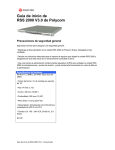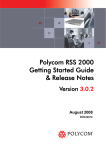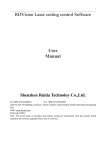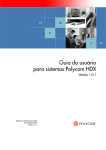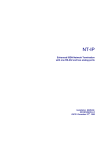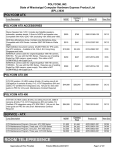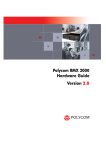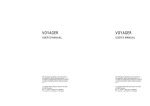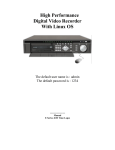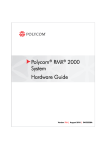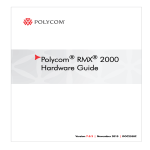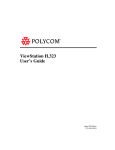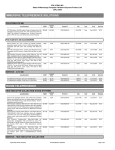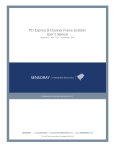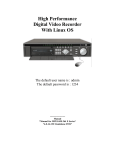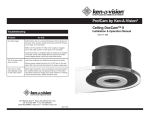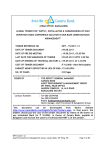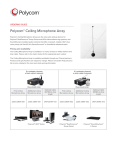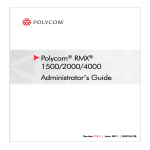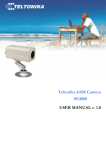Download RSS 2000 Getting Started Guid and Release Notes v 3.0.0
Transcript
Polycom ™ RSS 2000 V3.0.0.000 Getting Started Guide General Safety Precautions Follow these rules to ensure general safety: • Keep the area around the Polycom RSS 2000 unit clean, free of clutter and well ventilated. • Decide on a suitable location for the equipment rack that will hold the RSS 2000 unit and is near a grounded power outlet. • • Use a regulating uninterruptible power supply (UPS) to protect the RSS 2000 unit from power surges and voltage spikes, and to keep it operating in case of a power failure. Hardware Specification Pentium 4, 2.8Mhz,2G RAM,250G Hardisk. • Form Factor: 1U 19” rack mount • Height: 1.73” (44 mm) • Width: 16.83” (430 mm) • Depth: 15.35” (390 mm) • Gross Weight: 22.4 lbs (10.2 kg) • Power Supply: Thermal controlled 220W ATX AC power supply w/PFC • AC Voltage: 100 - 240 VAC, 60-50 Hz, 5-3 Amps XP OS DOC2207A RSS 2000 V3.0 Getting Started guide - Release Note - Final - February 26, 2008.doc Preparations Obtain the following information from your network administrator: • RSS 2000 unit, Subnet Mask and Default Gateway IP addresses • Gatekeeper IP address, Prefix, and E.164 of the RSS 2000. Unpacking and Installing the RSS 2000 1 Place the RSS 2000 unit on a stable flat surface in the selected location. 2 To connect to the power source, insert the power cable into the Power connector on the rear panel of the MGC+ unit and insert the Power cable into the power source socket. 3 Connect the lan cable to LAN1 in the back of the system. 4 Turn on the power switch. DOC2207A RSS 2000 V3.0 Getting Started guide - Release Note - Final - February 26, 2008.doc Initial RSS 2000 IP Configuration The system is shipped with a default IP address: IP Address:192.168.1.254 Subnet Mask: 255.255.255.0 Gateway: 192.168.1.1 There are two ways to change the initial IP address of the sytem: 1. Via a cross over lan cable 2. Via a RS232 or Telnet Console. 1. Changing the initial IP address via a cross over lan cable 1. 2. Connect a cross over lan cable to LAN1 in the RSS 2000. Set your laptop to the same segment of the RSS a. For example (in your laptop IP config setting): DOC2207A RSS 2000 V3.0 Getting Started guide - Release Note - Final - February 26, 2008.doc 3. Open internet explorer and browse to: http://192.168.1.254 4. Login to the system. User name: administrator Password: polycom 5. Go to system configuration->IP setting and modify the IP address , you can set a static IP or chose DHCP . Click the save button and than reset the system. DOC2207A RSS 2000 V3.0 Getting Started guide - Release Note - Final - February 26, 2008.doc 2.Changing the initial IP address via an RS232 Console or Telnet Another option to modify the IP address of the RSS 2000 is using the RS232 console. 1.Connect to the RS232 port – and activate the console (9600, 8bits) Login: polycom (or any administrator password) When login to the console, you will see the current IP address of the system. Help ? – show all available commands Changing the IP Address: set lan1 static 172.21.100.20 mask 255.255.224.0 [gw 172.21.96.254] Reset Password (back to polycom) User may reset the password of the administrator to default to ‘polycom’ reset password Note ! The same steps apply also for Telnet connection. Only one console can be connected at any given time (either Telnet or RS232 not both). The system is now ready for use, for additional configuration refer to the user guide. DOC2207A RSS 2000 V3.0 Getting Started guide - Release Note - Final - February 26, 2008.doc RSS 2000 Maximum Capacity Scenario Description Maximum Capacity Conference Recording How many conferences can be recorded simultaneously 2 conference or 2 EPs dialing in the same time1 H239 recorded link at a time Point to Point How many point to point calls can 1 recording be record (if both are dialing into the POLYCOM ™ RSS 2000) H323 Playback How many conferences can be playback in H323 10 Archive view How many streaming can be reviewed (unicast) – based on the Web Server capacity 50 Multicast for archives How many streaming can be reviewed (multicast) for existing archives 2 Clustering How many RSS can be stacked to support ? There is no limitation for the amount of RSSs that can be in a single clustering group. 1.In clustering mode , each RSS2000 still can support 10 H.323 playback .For example :one H.323 endpoint connect to RSS-A , it playback an archive from RSS-B clustering with RSS-A , the H.323 playback resource it occupied is taken from RSS-A . (There is a pending issue here , please refer the part of pending issues , RSS-365 ) 2. Archive view from the web in clustering mode will web resources from the RSS that the archive is base, not from the RSS that the user is connect to. DOC2207A RSS 2000 V3.0 Getting Started guide - Release Note - Final - February 26, 2008.doc Network TCP/UDP ports used by RSS2000 Endpoint/ H.323 Media Usage Manager Web https Trace Gatekeeper RAS Q.931 Socket H.245 Socket Live Broadcast Audio / Video Data On demand Protocol On Demand Archive On Demand Archive Type TCP TCP TCP UDP UDP UDP TCP TCP TCP UDP TCP TCP (optional) UDP(optional) Port Range 81 80 443 30011 1719 1720 1720 1730-1739 1800-1801 2000-2099 554 554 Random (for source port) Notes Regarding On Demand Archive The UDP ports used for on demand archives are randomly chosen. There are two ways to configure firewalls and Windows Media Player for usage with RSS2000 on demand archives. 1) Open an outbound UDP port range matching what is used by Windows Media Player, or open all UDP ports outbound from RSS2000 to effectively bypass the firewall for outbound traffic. Also open the port range used by Windows Media Player for inbound traffic to the viewing PC. This range is configurable in Windows Media Player, as seen in Figure 1 (Windows Media Player defaults shown). The user can check RTSP/UDP, check ‘Use ports’ and define the port range. 2) Disable UDP connections in Windows Media Player to force a TCP-only connection. This configuration utilizes only TCP port 554. As seen in Figure 2, unchecking RTSP/UDP removes the user’s ability to specify a port range and forces all connections to use TCP 554 only. DOC2207A RSS 2000 V3.0 Getting Started guide - Release Note - Final - February 26, 2008.doc Figure-1 DOC2207A RSS 2000 V3.0 Getting Started guide - Release Note - Final - February 26, 2008.doc Figure-2 DOC2207A RSS 2000 V3.0 Getting Started guide - Release Note - Final - February 26, 2008.doc Polycom ™ RSS 2000 V3.0 Release Notes RSS2000 V3.0 Upgrade User Guide 1, New Systems – New Installations For new installations , customer need to activate the RSS before starting to use . Process: As you aware, RSS 2000 V3.0 includes two type of activation keys: Keycode definition Package Name K-keycode U-keycode Description Option Activation (Basic, Multicast, Clustering) New Version activation (Will not affect the current installed options) Log into RSS and go to Product Activation Click Polycom Resource Center , go to the PRC and under product activation: DOC2207A RSS 2000 V3.0 Getting Started guide - Release Note - Final - February 26, 2008.doc For new installation, the system will be shipped with a K License, that will require the user to go to the PRC and receive a K Keycode: The user will receive a K Keycode with his options (Either none, Clustering or Multicast) After entering the K Keycode – the user will need to go back to the PRC and receive now a U Keycode: DOC2207A RSS 2000 V3.0 Getting Started guide - Release Note - Final - February 26, 2008.doc Enter 3.0 in the Version field and enter the System Serial# in the Serial Number field , then customer will receive a U-Key code (As taken from the product activation section on the RSS 2000 Web UI): After entering both the K Keycode and the U keycode the product will be ready to be used: DOC2207A RSS 2000 V3.0 Getting Started guide - Release Note - Final - February 26, 2008.doc 2, Current Install base (Existing systems that require upgrade) Preparation before Upgrade 1: Obtain the 3.0 upgrade package and activation keys from Polycom website or your local service center. Save it in a folder on your desktop.(more details , please read RSS2000 user manual v3.0) pgrade package definition Package Name Part1: RSS2000.3.0.0.0_part1_full function_with English&Japanes&Chinese . pkg Part2: RSS2000.3.0.0.0_part2_additional language. Pkg Keycode definition Package Name K-keycode U-keycode Description With full function –support English and Japanese Support all additional language (except English/Chinese and Japanese) Description Option Activation (Basic, Multicast, Clustering) New Version activation (Will not affect the current installed options) NOTE: z For RSS2000 running System software 1.0, K-keycode and U-Keycode are both needed. z For RSS2000 running 2.0, Only U-keycode is needed (It doesn’t include multicast or clustering option , if you want to get these option , you need to buy another K-keycode ). How to receive Key code Please refer same introduction in the part of “new installation” NOTE: z Before upgrade , Please check your current version , we have different process for v1.0 and v2.0 upgrade. z Keep your RSS2000 powered on and connected to the network during the upgrade. DOC2207A RSS 2000 V3.0 Getting Started guide - Release Note - Final - February 26, 2008.doc Upgrade from 1.0 to 3.0 1: Download upgrade package to RSS a) Log in to RSS , go to “ . - System Configuration > Upgrade/Reset System” page . b) Download the “RSS2000.3.0.0.0_part1_full function_with English &Japanes & Chinese . pkg” to RSS , then Restart Note : For More details on the download file process , please read “RSS2000 user manual V3.0” 2: Activate your RSS by Keycode a) After rebooting , log into RSS , “ . - System information > Product Activation” page. b) Paste your U-Keycode , click save . c) Paste your K-Keycode , click save . Notes : No need to restart . 3: Check the status Go to “ . - System information > Product Information” page DOC2207A RSS 2000 V3.0 Getting Started guide - Release Note - Final - February 26, 2008.doc If everything is ok , the version # /Activation Status /V3.0 Key code activation should have same status . (For multicast and clustering option , if you buy these 2 option , your RSS will show same status , if not , it will not be showed ) Note : Now you RSS can support English, Chinese and Japanese. If you want additional language options, you need to download and install the part with additional language options. For additional language options installation, please refer to the part in this documentation “Additional Language support “. DOC2207A RSS 2000 V3.0 Getting Started guide - Release Note - Final - February 26, 2008.doc Upgrade from 2.0 to 3.0 1: Download upgrade package to RSS a) Log in to RSS , go to “ . - System Configuration > Upgrade/Reset System” page . b) Download the “RSS2000.3.0.0.0_part1_full function_with English &Japanes & Chinese . pkg” to RSS , then Restart Note : More details about the download file process , please read “RSS2000 user manual V3.0” 2: Activate your RSS by Keycode a) After rebooting , log into RSS , “ . - System information > Product Activation” page. b) Paste your U-Keycode , click save . Notes : No need to restart . 3: Check the status Go to “ . - System information > Product Information” page DOC2207A RSS 2000 V3.0 Getting Started guide - Release Note - Final - February 26, 2008.doc If everything is ok , the version # /Activation Status /V3.0 Key code activation should have same status . (For multicast and clustering option , if you bought these 2 options , your RSS will show same status , if not , it will not be showed , In case the user already have installed K Keycode (Even on top of V2.0) with Clustering option – clustering will remain checked ) Note : Now you RSS can support English, Chinese and Japanese. If you want additional language options, you need to download and install the part with additional language options. For additional language options installation, please refer to the part in this documentation “Additional Language support “. DOC2207A RSS 2000 V3.0 Getting Started guide - Release Note - Final - February 26, 2008.doc Additional Language Support If you need 3.0 to support additional language (Not English/Chinese/Japanese) ,you need to follow this process . Image version check Please check RSS2000 image version following the commands below firstly. Only RSS2000 with image version 5 or above can be upgraded with additional language support. 1: Click on Start>Run>Enter “telnet 172.21.103.127 23” (without quotation marks), and Click OK. NOTE: The IP address above is for EXAMPLE ONLY. Please replace it with your RSS2000 IP address. 2: You will see a command prompt window after the command is executed. The window should look like below. 3: Enter the password for your RSS2000. Default password is polycom , then a system welcome screen appears. DOC2207A RSS 2000 V3.0 Getting Started guide - Release Note - Final - February 26, 2008.doc 4: At command prompt, enter “imageversion” (without quotation marks) 5: If the version # is “ 5” ( see the screenshot below ), indicates the RSS2000 can be upgraded with additional language options. 6: If the image version is not 5 , it will show unknown version , means if you want to support additional languages , need to refresh the image , the old image don’t have full support for additional languages, so please contact your service provider . Upgrade additional language package a) Log in to RSS , go to “ . - System Configuration > Upgrade/Reset System” page . b) Download the “RSS2000.3.0.0.0_part2_addtional languages . pkg” to RSS , then Restart DOC2207A RSS 2000 V3.0 Getting Started guide - Release Note - Final - February 26, 2008.doc New Features (Compare with V2.0.0.000) # JIRA# 1 RSS-248 2 RSS-207 RSS-225 RSS-247 3 4 5 6 EXT-405 7 8 RSS-239 9 RSS-219 10 RSS-220 11 RSS-274 12 13 RSS-54 14 15 RSS-265 16 RSS-234 Features Description RSS2000 should support active a recording task in Clustering Improvements next server when the recording capacity in last one is full . Gatekeeper Registration New Gatekeeper registration modes to support modes different types of Gatekeepers Turn on/off H.323 Configure Recording only system Playback Localization - languages WEB UI , TV-UI and documentation , IVR – VC 2.0 support Common Languages suite Support SIREN 22 Stereo in Single and Point to Point Siren22 Stereo Support calls. API provide the interface to support that administrator XML API Improvements can select any archive send to any playback site. Meet Polycom Security policy Https/SSL mode Disable update interface for end users , the update Windows security update package will be provided with the new release package policy by Polycom. Meets Polycom Security policy Disable Preview (Security) Disable Preview Restrict the max # of live Resource allocation Improvements streaming or web playback Media Tool Kit Media Tool Kit Enhancements, 4CIF/4SIF (SD) Enhancements Transcoding, and Link to the install shield Support Multicast for Live Streaming and Archive View Multicast improvement using Polycom player Streaming without Streaming without recording – TV Menu option recording Lan port configuration Configure Lan Speed HD Archive View Progress Bar indicate for HD Archive view availability – Progress Bar Email notification for NAT Email Link configuration for NAT Topologies Topology DOC2207A RSS 2000 V3.0 Getting Started guide - Release Note - Final - February 26, 2008.doc RSS2000 Policies and Limitations Subject H.323 Alias length Console Service Endpoint menu P2P recording maximum bandwidth Archive file size Media Player Support Archive playback H.323 playback System Reset LDAP integration H.323 preview Archive Converter Description The maximum length of the system H.323 alias name is 16 characters RS232 configuration: Baud rate 9600, Data bits 8, Parity None, Stop bits 1, Flow control OFF. ONLY ONE connection to the Console service is allowed, either by RS232 or by Telnet, but not both. 1. When schedule a dial out & record from the Web UI, RSS will loopback the video and NEVER show the menu unless a menu operation (FECC arrow keys or DTMF 2/4/6/8) is given from the endpoint. 2. When a pre-defined endpoint dials into the RSS and the endpoint has the "immediate recording" option, RSS will do the same as above. 3. When inviting an endpoint to a P2P recording room (using E.164 number of the P2P room followed by #/* and E.164 number of the invited endpoint ), the inviting endpoint will have the menu and the invited endpoint won’t have the menu 4. When two endpoints meet at a P2P recording room, only one of them can have the menu at a time. Maximum bandwidth for a P2P recording room is 1024K. If video protocol for P2P recording room is H.264, then the maximum bandwidth is 768K If the media file size exceeds 4GB, downloading it from Web UI may be incomplete. Windows Media Player 9/10 is required. WMP 10 is recommended. RealPlayer can also be used if WMP is properly installed. QuickTime player is not supported. Some third party media player such as Media Player Classic (MPC) and VLC can also be used, but they were not certify Archive playback with WMP does not support playback controls: Pause/Resume/FF/Backward, etc During H.323 playback, if there is packet loss and endpoint requests IFrame, RSS cannot apply the request. Since all audio/video data are from the media file. Hard reset (power off and on) is not recommended. Reset should be done via the Web UI or Console service whenever possible. Microsoft Active Directory only 1. Only two H323 devices can receive Preview –Meaning when there are 2 endpoints previewing on RSS2000 , the third one connect to RSS2000 will not receive preview , if these two endpoints receiving preview stop to preview or disconnect ,the third one still cannot receive , it need to re-connect . 2. HD or SD archives cannot be previewed. 3. No Transcoding for Preview – Meaning archive recorded in H263 will not be able to be preview by an endpoint connected in H264 and vice versa, however – endpoint support H264 and H263 – in case the archive is in H263 – the playback will work well. 4, In a clustered configuration, H.323 endpoint cannot receive a preview image of the archive that is not stored on the RSS unit that the endpoint is connected. This description should be added to the note her When using the RSS2000ArchiveConverter – the transcoded file loaded back to the RSS will be limited to 20 FPS DOC2207A RSS 2000 V3.0 Getting Started guide - Release Note - Final - February 26, 2008.doc Subject Calling with IP address to an RSS that is register with a GK - the call is rejected Description When working in routed mode with a gatekeeper, devices that are trying to call to the RSS – with IP address, will be rejected if they are not register to the same GK. This is the right policy when working with routed mode on the GK MGC Integration 1, When working with the MGC in Video switching mode – the RSS will indicate HD 2, You can disable HD or define the minimum rate for HD in the single point recording setting in the RSS V2.0, or as alternative disable the HD in system.cfg of the MGC Playback of H263 recording to the HDX may result with some video artifacts 1.Only the archives, the view right of which was “Allow All”, can be shared. 2 . During clustering, the archives, that wasn’t saved on the local RSS2000, can not be deleted, and it’s properties can not be modified. Each RSS 2000 is capable of 2 recording and 8 H323 playbacks (total of 10 H323 Connections). 1,When using the RSS Hunting function with Cisco GK – the GK will hunt to the next available RSS after the RSS is full with 10 H323 connection. 2, Hunting can only support by PN/SE2000; RDVISION GK ; Cisco GK . RSS can not pause a streaming without recording task ,just to use stop function V3.0 have 2 upgrade packages , can not be covered in one package , part is with all functions , part2 is with multi languages package, so some customer need to upload 2 packages . For details , please read the V3.0 upgrade guide 1, image requirement: Languages (except English/Japanese/Chinese) require image V5.0 . For details , please read the V3.0 upgrade guide (it is a part of this document) 2, IVR support – RSS2000 V3.0 only support English/Chinese/Japanese IVR , RSS will play English IVR for all other languages – however, the user can manually upload any IVR he prefer to accommodate his language requirements H.263 / H.263+ 4CIF archives can not be uploaded to RSS When moving mouse cursor on the play button of an archive , if it is an HD archive being transcoding , so play button will be a special status , then you will see a percentage number to show the transcoding process Limitation is that if uses don’t refresh the page , the percentage will not have any update HDX Interoperability Clustering Hunting Pause without recording (RSS-381) V3.0 upgrade Multi language support Upload Utility HD archives transcode status DOC2207A RSS 2000 V3.0 Getting Started guide - Release Note - Final - February 26, 2008.doc Known Limitations; JIRA# RSS-120 Subject Overlapping names RSS-136 VSX 5000-8000 Interoperability RMX 2000 Interoperability RSS-141 VNGR-4291 RSS-142 RSS-137 RSS-121 RSS-129 RSS-130 RSS-157 RSS-148 RSS-153 RMX 2000 Interoperability ViewStation Interoperability IVRs Maximum frame rate for recording and playback Point to Point recording Embedded Multipoint on the VSX Sony HG90 version: 2.11 Beta Interoperability H239 Content resolution RSS-154 RSS-147 Econf integration Aethra X7 integration RSS-301 RSS-391 RMX 2000 integration 2CIF/2SIF support RSS-276 RSS-373 LAN Setting Stereo support RSS-256 Description The monitor screen displays an overlapping names of VSX8000 and RSS in a MGC meeting room The RSS 2000 support the VSX 5000-8000 when the VSX is set to motion (Not Sharpness nor Promotion) The RMX 2000 connects secondary to the RSS 2000 in the rate of 64Kbps (No support for G.728 at the RMX 2000 (RMX 2000 connect to the HDX and VSX at G.729A in 64K which is not supported by the RSS 2000)) – recording at this low video rate is not recommended in any case. While RSS2000 is connected to RMX2000 in SIF when the RMX is set to Sharpness , an archive of it is tagged as H.264 SD. ViewStation show blue then green screen at the beginning of a connection to RSS2000 When recording an IVR message – it’s require to add additional 1 second of silence for each recording, to prevent message truncation with VSX and Viewstations Maximum frame rate for recording and playback in the recording room is 20 fps in H.264 and 25 fps in H.261/H.263 HD is not supported in Point to Point recording. When using an HD endpoint it’s recommended to dial directly to the recording room [RSS2000 Prefix][Recording Room Prefix] and not to connect to the Recording room via the H323 Menu. When recording a multipoint on a VSX – first connect the endpoint to the VSX and only than connect to the RSS 2000 Sony HG90 can connect in HD only. The RSS 2000 menu is in CIF (Not in HD) as so the HG 90 will connect as secondary. The RSS 2000 support H263 content (Not H264) – as most endpoint currently support H263 content – in order to prevent interoperability issue, when playing back the stream (In H323) the RSS will not support H264 content (Lower common nominator) France Telecom eConf can not get video from RSS Connect Aethra X7 to RSS2000 @1920K ,the X7 sends 720p, but receives CIF from the RSS2000. RSS2000 can only support CIF/SIF for menu . HD Recording with the RMX 2000 is supported only on full screen layout RSS can not encode 2CIF/2SIF as a standard resolution when transforming to WMV file , the WMV file is not correct resolution , just keep same scale with 2CIF or 2SIF , so the anemographic video will be showed on PC . Disable promotion on the VSX when working with the VSX The same LAN Speed need to be forced on the RSS side and in the switch side. SIREN 22 Stereo is supported for H323 Playback. When playing the archive using windows media player - the archive will be played in mono. RSS takes a while to respond to a "stop recording" action at endpoint , can not end and play IVR immediately . DOC2207A RSS 2000 V3.0 Getting Started guide - Release Note - Final - February 26, 2008.doc Pending issues JIRA# RSS-189 Subject Integration with MGC RSS-365 Clustering Limitation RSS-132 RSS-133 RSS-282 HDX Interoperability FF or REW action within HD archive playback may cause some video artifacts Distortion/freezing in converted video using media tool kit RSS-389 Description When working with the MGC in Video switching mode – the RSS will indicate HD You can disable HD or define the minimum rate for HD in the single point recording setting in the RSS V2.0 Playback of an archive stored on an RSS2000 unit (Unit A) from the third EP connected to another RSS2000 unit (Unit B) may triggered termination of ongoing playback of the same archive on Unit A from two other EPs also connected to Unit B earlier than the third EP in a clustered two RSS configuration. Playback of H263 recording to the HDX may result with some video artifacts When performing Fast Forward or Backward on an HD archive (with the HDX) – some video artifacts Converting HD archive using the media tool kit to H.263 and uploading the converted file back to the RSS. When playing back the converted file with the VS or VSX some video artifacts may appear. DOC2207A RSS 2000 V3.0 Getting Started guide - Release Note - Final - February 26, 2008.doc
























